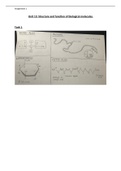Assignment 1
Unit 13: Structure and function of biological molecules
Task 1
,Assignment 1
,Assignment 1
Molecule Polymer/monomer Main biological function
Amino acids Monomer They are often referred to
as the ‘Building blocks’ of
proteins. They are
compounds in your body
which play multiple critical
roles. Vital processes such
as the construction of
proteins and the synthesis
of hormones and
neurotransmitters involve
them.
Proteins polymer Proteins perform a wide
variety of cell functions. By
providing structural support
and by acting as enzymes,
carriers, or hormones, they
assist in metabolism. Amino
acids are the building blocks
of proteins (monomers).
Carbohydrates Polymer The four major purposes of
the body's carbohydrates
are to provide energy for
other uses, store energy,
construct macromolecules
and lend protein and fat.
Fatty acids monomer 1) signal-transduction
pathways
2) cellular fuel sources
3) the composition of
hormones and lipids
4) the modification of
proteins
5) energy storage within
adipose tissue (specialized
fat cells) in the form of
triacylglycerols.
Triglycerides polymer When they are metabolised
in the human body, they
play a significant function as
an energy source. They are
very energy-rich, providing
twice the energy of either
carbohydrates or proteins
and can be used to provide
, Assignment 1
the body with energy as
well.
Phospholipids Polymer They provide barriers to the
cell membranes in order to
protect the cell, and they
create barriers within those
cells for the organelles.
Phospholipids function
through membranes to
establish pathways for
different substances.
Nucleotides monomer A DNA and RNA building
block. They also have cell
signalling, metabolism, and
enzyme reactions-related
functions. Outside of
genetic information storage,
they even perform a
number of functions, such
as messengers and energy-
moving molecules.
DNA Polymer Using the genetic code to
store the sequence of
amino acid residues in
proteins. Cells create a copy
of a stretch of DNA inside
the nucleic acid RNA to read
the genetic code.
Task 2
Chromatography of amino acids
Chromatography involves the process of dissolved substances between two phases, the stationary
phase, and the mobile phase. With paper chromatography, the stationary phase is the when the
molecules are bound to the paper fibres (cellulose), while the mobile phase is the running solvent.
The solvent used when separating amino acids (BAW) is more hydrophobic than water. When
separating amino acids, more hydrophilic amino acids will associate more with the stationary phase
and will move slower. More hydrophobic amino acids will associate more with the mobile phase, and
will move further.
Experiment
Aim: The ultimate aim was to separate out and name the amino acids in a mixture by using the
process of TLC.
Theory:





